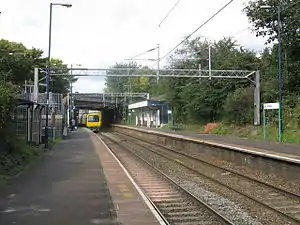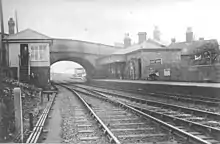Hamstead | |
|---|---|
 Looking towards Walsall, in 2008 | |
| General information | |
| Location | Hamstead, Birmingham England |
| Coordinates | 52°31′48″N 1°55′41″W / 52.530°N 1.928°W |
| Grid reference | SP049925 |
| Managed by | West Midlands Trains |
| Transit authority | Transport for West Midlands |
| Platforms | 2 |
| Other information | |
| Station code | HSD |
| Fare zone | 3 |
| Classification | DfT category E |
| History | |
| Original company | Grand Junction Railway |
| Pre-grouping | London and North Western Railway |
| Post-grouping | London, Midland and Scottish Railway |
| Key dates | |
| 4 July 1837 | Opened as Hamstead and Great Barr |
| 1 May 1875 | Renamed Great Barr |
| 25 March 1899 | Resited |
| 6 May 1974 | Renamed Hamstead |
| Passengers | |
| 2018/19 | |
| 2019/20 | |
| 2020/21 | |
| 2021/22 | |
| 2022/23 | |
| Location | |
| Notes | |
Passenger statistics from the Office of Rail and Road | |
Hamstead railway station serves the Hamstead, Great Barr and Handsworth Wood areas of Birmingham, England. It is located at the junction of Rocky Lane and Old Walsall Road, Hamstead, at Birmingham's border with the borough of Sandwell. It is situated on the Chase Line, part of the former Grand Junction Railway, opened in 1837. The station, and all trains serving it, are operated by West Midlands Trains.
A bridge carrying Old Walsall Road over the railway serves as the only means for passengers to cross from one platform to the other.
History



The station was opened by the Grand Junction Railway (GJR) on 4 July 1837, and was named Hamstead and Great Barr; it was renamed Great Barr by the London and North Western Railway (LNWR, the successor to the GJR) on 1 May 1875. The same year an LNWR Type 3, 'size C' signalbox was erected at the station. The platforms were originally on opposite sides of the road bridge, with the down (Walsall-bound) platform to the west, but that platform was resited opposite the up platform on 25 March 1899. Sidings, controlled by the signalbox, served the adjacent Hamstead Colliery, west of the station and north of the line.
The line through the station was electrified in 1966 as part of the London Midland Region's electrification programme.[1] The actual energization of the line from Coventry to Walsall through Aston took place on 15 August 1966.[2] The road bridge was replaced and the signalbox removed as part of the works (the nameplate from the signalbox is now in Chasewater Railway Museum[3]). The station was renamed Hamstead on 6 May 1974.[4][5]

Occasionally, such as during Storm Dennis in February 2020, the nearby River Tame overflows and floods the station.
Facilities
The wooden ticket office is located on the Birmingham New Street-bound platform and is staffed part-time seven days per week. A self-service ticket machine is situated outside this structure for use when the office is closed and for collecting pre-paid tickets. A modern waiting shelter is located on the opposite side, with customer help points, CIS screens and automated announcements on both sides used to offer train running information. Both platforms have step-free access from the street.[6]
Services
The typical Monday-Saturday daytime service sees two trains per hour in each direction between Walsall and Birmingham New Street (and through towards Wolverhampton).[7] Services are reduced to one train per in the evenings and on Sundays.[8]
All trains serving the station are operated by West Midlands Trains.
In the case of engineering work on the line (which often occurs on Sundays), Hamstead is usually the last stop for trains to Birmingham from Walsall or the Chase Line. Such services deviate from normal running at Perry Barr North Junction and enter New Street through Soho, merging with the Birmingham to Wolverhampton line just south of Smethwick Rolfe Street. A replacement bus service operates on these days to Hamstead from New Street, calling Duddeston, Aston and Witton beforehand.
Nearby
Hamstead also serves:
- Perry Hall Park (west end)
- Sandwell Valley
References
- ↑ Nock, O.S. (1966). Britain's New Railway. London: Ian Allan. pp. 147–159.
- ↑ Gillham, J.C. (1988). The Age of the Electric Train - Electric trains in Britain since 1883. Shepperton: Ian Allan. p. 169.
- ↑ "Signage". Chasewater Railway Museum. Retrieved 5 April 2020.
- ↑ Butt, R.V.J. (1995). The Directory of Railway Stations. Yeovil: Patrick Stephens Ltd. pp. 108, 113. ISBN 1-85260-508-1. R508.
- ↑ Slater, J.N., ed. (July 1974). "Notes and News: Stations renamed by LMR". Railway Magazine. London: IPC Transport Press Ltd. 120 (879): 363. ISSN 0033-8923.
- ↑ "Hamstead (Birmingham) (HSD)". National Rail Enquiries.
- ↑ "Timetable - Chase Line" (PDF). West Midlands Railway.
- ↑ GB eNRT May 2017 Edition, Table 70
External links
- Train times and station information for Hamstead railway station from National Rail
- Rail Around Birmingham and the West Midlands: Hamstead railway station
- Railways of Warwickshire entry
| Preceding station | Following station | |||
|---|---|---|---|---|
| West Midlands Railway | ||||
| West Midlands Railway Wolverhampton-Birmingham-Walsall | ||||
| Historical railways | ||||
Line open, station closed | London and North Western Railway | Line and station open |
||